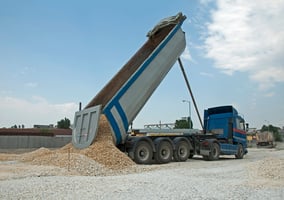If you're stepping into the world of aggregate hauling or looking to expand your operation, one of...
The Best Tarp Systems for Dump Trucks (and Why You Need One)
When it comes to hauling aggregates like sand, gravel, or crushed stone, a tarp system isn’t just a nice-to-have — it’s a necessity. Whether you’re a seasoned owner-operator or new to the world of end dump trucking, the right tarp system can save you time, money, and headaches on every load.
Why Do You Need a Tarp System?
There are three main reasons why tarp systems are critical in the aggregate hauling business:
-
Regulatory Compliance
Most states, including Texas, require loose materials to be covered during transport to avoid road hazards. Failure to comply can lead to fines, citations, or job site bans. -
Safety and Liability
Flying debris isn’t just a legal risk — it’s a real hazard. A tarp system prevents rocks, sand, or other materials from escaping your bed, which helps protect you and everyone else on the road. -
Protecting the Load
Weather can wreak havoc on an uncovered load. A quick rainstorm can turn dry limestone into a mess or reduce the usability of certain materials, delaying your delivery and payment.
Types of Tarp Systems
Not all tarp systems are created equal. Here’s a breakdown of the most common types for dump trucks and trailers:
1. Manual Tarp Systems
-
Operated by hand (crank or pull)
-
Lower upfront cost
-
More labor-intensive
-
Better for short hauls or part-time use
2. Electric Tarp Systems
-
Powered by a motor with a switch or remote
-
Easy to use from the cab or ground
-
Great for efficiency and safety
-
Most common with full-time aggregate haulers
3. Automatic/Side-to-Side Rollers
-
Covers/unrolls across the trailer automatically
-
Often used on belly dumps or side dumps
-
Offers complete coverage and quick operation
What to Look for in a Tarp System
When choosing a tarp system for your end dump, here’s what we recommend:
-
Heavy-duty mesh or vinyl: Mesh is great for gravel and rocks; vinyl is best for fine material and weather protection.
-
Spring arms or tension systems: These help keep the tarp tight and reduce flapping or tearing.
-
Wind resistance features: Side flaps and reinforced edges reduce wear and tear.
-
Ease of use: The faster you can secure your load, the more money you make per day.
326 Trucking Tip:
Electric tarp systems with mesh tarps are the most common setup we see across our fleet of partnered owner-operators — offering the perfect balance of compliance, ease, and durability.
We also recommend keeping extra bungees and a tarp patch kit in your truck for emergency fixes.
Tarp Systems & Plant Requirements
Most aggregate plants require:
-
A fully functional tarp system
-
The load to be covered before exiting the yard
-
No loose debris sticking out of the trailer
If your tarp is broken, you may be turned away or fined. That’s lost revenue and wasted fuel — something no owner-operator wants.
Ready to Get Started?
If you’re thinking about getting into aggregate hauling, we’d love to talk. Whether you already have a truck and trailer or you’re just now exploring the idea, we’re happy to walk you through it.
Reach out to us at trucks@326trucking.com
Or check out our Owner Operator Onboarding Info Page




